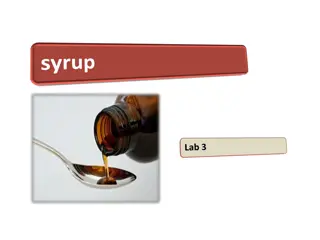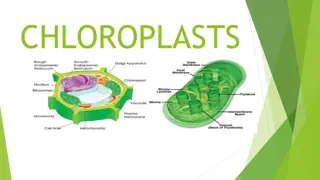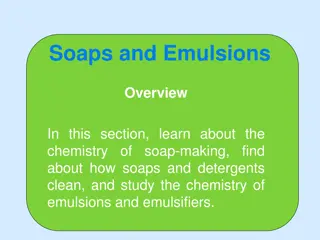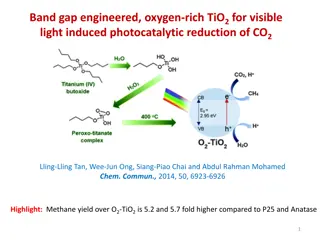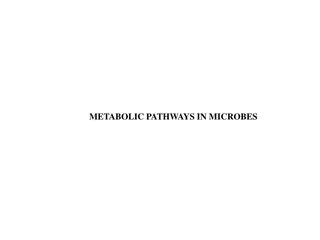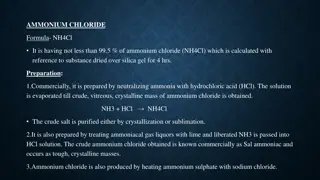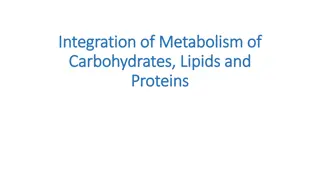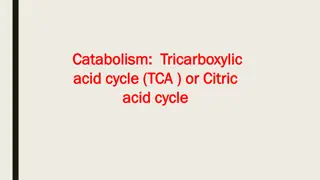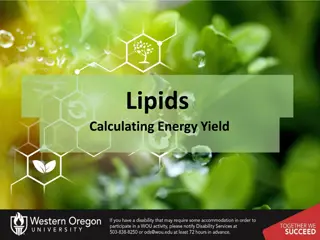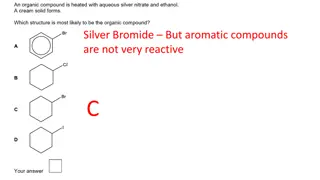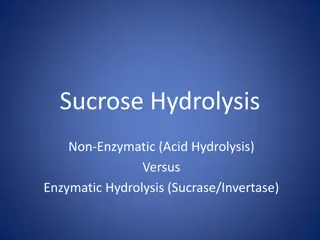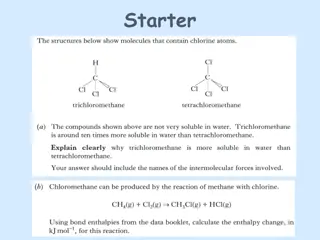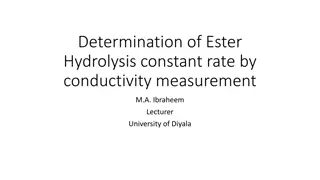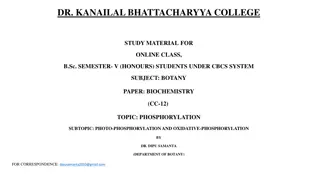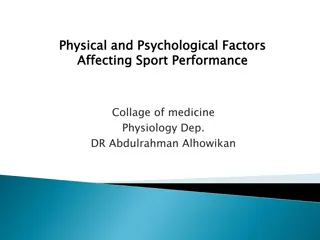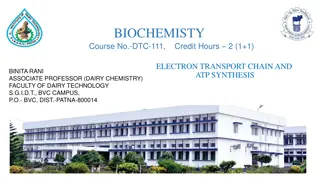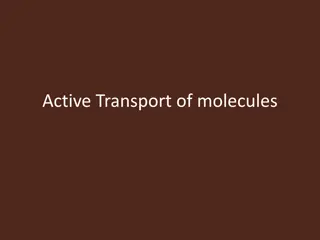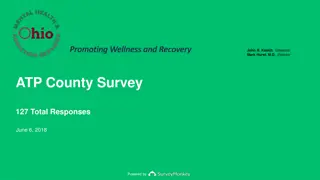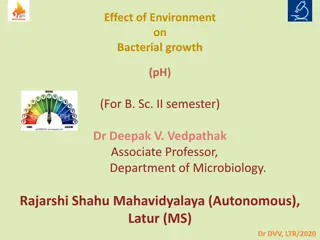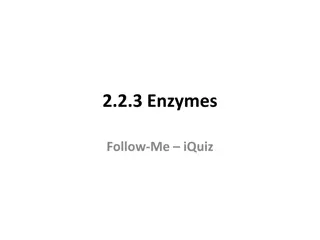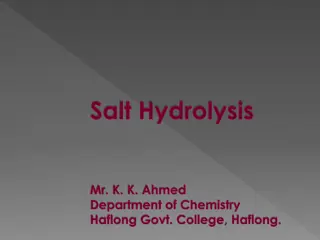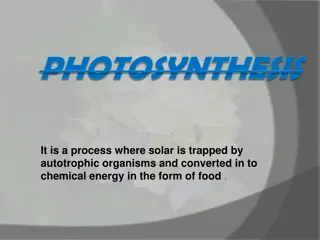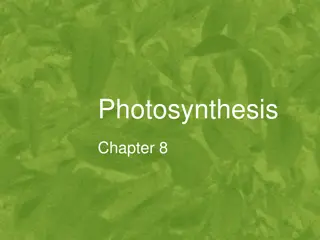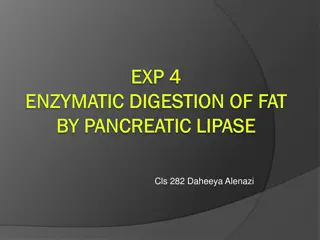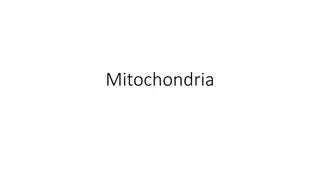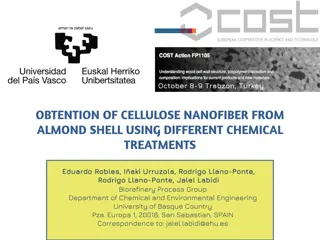Understanding Motor Proteins and Cytoskeletal Dynamics in Cell Biology
Motor proteins, such as myosin, kinesin, and dynein, utilize chemical energy to move along cellular tracks, influencing processes like muscle contraction, organelle movements, and cellular migration. With the ability to translocate using ATP hydrolysis, these proteins play crucial roles in various c
5 views • 14 slides
Understanding Syrups: Types, Formulations, and Storage Considerations
Syrups are sweet, viscous liquids used in pharmaceutical preparations. They can be non-medicated for flavoring or medicated for therapeutic purposes. There are sugar-based and sugar-free syrups, with sucrose preferred for its purity and handling ease. Preservatives like benzoate and sorbic acid are
4 views • 16 slides
Regulation of Energy Homeostasis by AMPK System and Its Modulation Factors
The AMPK system plays a crucial role in regulating energy homeostasis by sensing the cellular AMP:ATP ratio and responding to metabolic stresses that affect ATP production or consumption. AMPK is activated by factors such as hypoxia, glucose deprivation, and metabolic inhibitors, as well as by compo
0 views • 27 slides
Understanding Cellular Respiration and Metabolism in Living Organisms
Cellular respiration is a vital process in all living cells, producing energy through chemical reactions. Metabolism, consisting of anabolism and catabolism, maintains growth and function. ATP plays a central role as energy currency in cells. Through stages like glycolysis and the Krebs cycle, cellu
0 views • 16 slides
Understanding Digestion and Absorption in the Gastrointestinal Tract
Digestion and absorption in the gastrointestinal tract are crucial processes for breaking down carbohydrates, fats, and proteins into smaller compounds that can be absorbed by the body. Carbohydrates undergo hydrolysis to convert into monosaccharides, fats are broken down from triglycerides, and pro
1 views • 22 slides
Understanding Muscle Contraction: Sliding Filament Theory and Cross Bridge Cycle
Explore the fascinating process of muscle contraction through the sliding filament theory and cross bridge cycle. Developed by scientists in 1954, this mechanism involves the interaction between myosin and actin filaments, regulated by calcium and ATP. The cycle includes steps such as myosin binding
0 views • 11 slides
Understanding Bacterial Photosynthesis: Types and Processes
Photosynthesis is the conversion of light energy into chemical energy, crucial for growth and production of ATP. Prokaryotes such as cyanobacteria, purple and green bacteria, and halobacteria demonstrate different forms of photosynthesis. Oxygenic photosynthesis, found in cyanobacteria, releases oxy
2 views • 20 slides
Understanding Chloroplasts: Structure, Function, and Marker Enzymes
Chloroplasts are vital organelles in plant cells responsible for photosynthesis, converting light energy into chemical energy. They contain chlorophyll pigments for light absorption and play a crucial role in synthesizing foodstuffs. Marker enzymes such as RUBISCO, NADP-Reductase, and ATP synthase a
1 views • 7 slides
The Chemistry of Soaps and Emulsions: An Overview
Explore the fascinating world of soap-making and emulsions' chemistry. Discover how soaps are formed through alkaline hydrolysis, the structure of soap molecules, and how they clean oily stains effectively. Learn about emulsions, emulsifiers, and the science behind soap production.
1 views • 24 slides
Band Gap Engineered Oxygen-Rich TiO2 for Visible Light-Induced Photocatalytic Reduction of CO2
Band gap engineering and oxygen-rich modifications in TiO2 have been explored for visible light-induced photocatalytic reduction of CO2. The engineered O2-TiO2 photocatalyst exhibited significantly higher methane yield compared to conventional TiO2 types. The preparation involves hydrolysis of titan
1 views • 17 slides
Understanding Metabolic Pathways in Microbes
Metabolism in living organisms involves anabolism and catabolism, where anabolism generates essential biomolecules for growth using energy, while catabolism breaks down nutrients for energy release. Anabolic processes include synthesis of carbohydrates, lipids, proteins, nucleic acids, and other gro
7 views • 24 slides
Overview of Ammonium Chloride: Properties, Preparation, and Uses
Ammonium Chloride, with the formula NH4Cl, is a compound containing not less than 99.5% NH4Cl. It is prepared commercially by neutralizing ammonia with hydrochloric acid or treating ammoniacal gas liquors with lime. The compound is essential for maintaining acid-base equilibrium, acts as an expector
2 views • 4 slides
Understanding the Integration of Carbohydrate, Lipid, and Protein Metabolism
The integration of metabolism involving carbohydrates, lipids, and proteins can be divided into three stages: hydrolysis to simpler units, preparatory stage, and oxidative stage. In the hydrolysis stage, complex polysaccharides, lipids, and proteins are broken down to simpler forms. The preparatory
3 views • 13 slides
Overview of Cellular Respiration Pathways and ATP Generation
Cellular respiration involves key processes like the Tricarboxylic Acid Cycle (TCA), Electron Transport Chain, and ATP generation pathways. The TCA cycle utilizes Acetyl-CoA to produce energy-rich molecules, while the Electron Transport Chain facilitates ATP synthesis through oxidative phosphorylati
0 views • 18 slides
Energy Yield from Lipid Oxidation Process
Understanding the energy generation process from lipid oxidation involves the conversion of fatty acids into Acetyl-CoA through multiple rounds of oxidation, which then enter the Krebs cycle to produce ATP. Each round of oxidation results in the production of Acetyl-CoA, NADH, FADH2, and net gains o
0 views • 7 slides
Understanding the Electron Transport Chain in Bacteria
The electron transport chain in bacteria plays a crucial role in generating additional ATP by oxidative phosphorylation. It involves the transfer of electrons from NADH and FADH2 to oxygen through a series of membrane-associated electron carriers. The chemiosmotic theory explains how this process fu
4 views • 10 slides
Synthesis of Salicylic Acid: Theory, Derivatives, and Applications
Salicylic acid is synthesized from methyl salicylate through ester hydrolysis with aqueous alkali. It is a versatile compound used in organic synthesis, as a plant hormone, and derived from salicin metabolism. The derivatives of salicylic acid can minimize gastric disturbances and enhance therapeuti
4 views • 12 slides
Organic Chemistry Concepts and Reactions
Learn about reactions involving silver bromide, nucleophilic substitution to prepare ethers, steam and acid catalyst reactions, reaction mechanisms using curly arrows, allyl bromide reaction with sodium hydroxide, alcohol synthesis, alkaline hydrolysis, and bromine water identification. Understand m
0 views • 12 slides
Understanding Sucrose Hydrolysis and Reducing Sugars in Carbohydrate Chemistry
This content delves into the mechanisms of sucrose hydrolysis through non-enzymatic and enzymatic processes, highlighting disaccharides like sucrose, lactose, and maltose. It explores the significance of glycosidic bonds in carbohydrate structures and discusses the reducing capacity of sugars such a
7 views • 16 slides
Understanding Proteins: Functions, Structure, and Breakdown
Explore the world of proteins, from their essential functions in living organisms to the chemistry of amino acids that form them. Learn how proteins are structured, the significance of amide links, and how they are broken down through hydrolysis. Delve into the importance of essential amino acids an
0 views • 17 slides
Determination of Ester Hydrolysis Constant Rate by Conductivity Measurement
This study focuses on determining the ester hydrolysis constant rate through conductivity measurement, presenting a second-order reaction example. Conductivity meter is utilized for accurate monitoring. The procedure involves utilizing equal concentrations of ester and sodium hydroxide, measuring co
0 views • 6 slides
Amino Acid Absorption Mechanisms in Small Intestine
Amino acid absorption in the small intestine is an active process requiring energy derived from ATP hydrolysis. It involves two main mechanisms: carrier proteins transport system and glutathione transport system. The carrier proteins transport system uses ATP energy for absorption, while glutathione
0 views • 18 slides
Colorimetric Detection of Hydrogen Peroxide Using Magnetic Rod-Based Metal-Organic Framework Composites
Nanomaterials, particularly magnetic rod-based metal-organic frameworks composites, are gaining attention for their exceptional properties and various applications in different fields. This study by Benjamin Edem Meteku focuses on using these composites for colorimetric detection of hydrogen peroxid
0 views • 16 slides
Understanding Photophosphorylation and Oxidative Phosphorylation in Biochemistry
Phosphorylation is the process of ATP production from ADP, occurring in two main forms - Photophosphorylation and Oxidative Phosphorylation. Photophosphorylation involves utilizing light energy to convert ADP to ATP, with two types: Cyclic and Non-Cyclic. Oxidative Phosphorylation uses energy from t
0 views • 15 slides
Understanding Physical and Psychological Factors in Sports Performance
This lecture covers important aspects of sport performance, including muscle metabolic systems, recovery processes, nutrients used during activity, effects of smoking and heart disease on performance, body fluids and salt balance, and the impact of drugs on athletes. Topics discussed include ATP ene
0 views • 23 slides
Assay of Aspirin by Indirect Acid-Base Titration
Indirect titration, also known as residual titration, is an analytical technique used to determine the weight of an unknown sample by employing excess standard solution. In the case of aspirin, which is a weak acid undergoing slow hydrolysis, back titration with NaOH and HCl is utilized to overcome
1 views • 13 slides
Understanding Electron Transport Chain and ATP Synthesis in Biochemistry
This course delves into the intricacies of electron transport and oxidative phosphorylation in biochemistry, elucidating how NADH and FADH2 are re-oxidized to generate ATP in eukaryotes and prokaryotes. It explores redox potential, oxidation-reduction reactions, and the role of standard redox potent
0 views • 20 slides
Understanding Active Transport of Molecules: Driven by ATP Hydrolysis
Active transport, fueled by ATP hydrolysis, facilitates the movement of molecules against their concentration gradients, essential for processes like ion pumping across membranes. The Na+-K+ pump, a prime example, utilizes ATP to transport Na+ and K+ ions across cellular membranes, maintaining impor
0 views • 23 slides
Promoting Wellness and Recovery ATP County Survey Results
Survey conducted on June 6, 2018, with 127 total responses representing various counties. Participants reported on entities represented, counties served, behavioral health services, recovery supports provided, obstacles in accessing ATP services for clients, and more. Illustrative images provided fo
0 views • 11 slides
pH Effects on Bacterial Growth: The Influence of Environment
This study explores the impact of pH levels on bacterial growth, highlighting the minimum, optimum, and maximum pH requirements for different categories of microbes - acidophiles, neutrophiles, and alkaliphiles. It delves into the consequences of pH variations on cellular processes like DNA stabilit
0 views • 8 slides
Accelerate Your Aviation Career with ATP-CTP Course Available at Top Schools
Las Vegas Flight Academy has a specialty programme referred to as the ATP-CTP Course Available programme that can help get you directly to the cockpit seat of an airline transport aircraft as quickly as possible. The highest quality instructors and a
0 views • 5 slides
Acquisition, Tracking, and Pointing (ATP) for NG-OWC System in Drone Networks
The research discusses the implementation of Acquisition, Tracking, and Pointing (ATP) in Next-Generation Optical Wireless Communication (NG-OWC) systems for drone networks. It covers the background of drone networks, ATP overview, schemes, tracking mechanism, current developments, challenges, and c
0 views • 16 slides
Understanding Metabolism: Enzymes and ATP
Explore the concept of metabolism through the roles of enzymes and ATP. Learn about chemical reactions in living cells, substrate interactions, and the essential functions of Adenosine Triphosphate. Test your knowledge with interactive quizzes and uncover the key principles governing cellular proces
0 views • 50 slides
Understanding Salt Hydrolysis in Chemistry
Salt hydrolysis is a chemical process in which a salt reacts with water to produce an acid and a base. This reaction occurs when the cation or anion of the salt interacts with water, resulting in either an acidic or basic solution. The type of hydrolysis depends on the strength of the acid and base
0 views • 6 slides
Understanding Cellular Respiration: Energy Production in Organisms
Organisms can be classified into autotrophs that use sunlight for photosynthesis and heterotrophs that rely on consuming food. Regardless of food source, all organisms obtain energy through cellular respiration, a process that converts stored chemical energy into ATP. This energy currency is essenti
0 views • 21 slides
Understanding Photosynthesis and Photophosphorylation Processes
Photosynthesis is a vital process where autotrophic organisms trap solar energy to convert it into chemical energy in the form of food. Non-cyclic photophosphorylation involves the transfer of phosphate groups and ATP synthesis utilizing light energy. This process takes place at photosystem II in ch
0 views • 10 slides
Understanding Energy and Photosynthesis in Living Organisms
This content delves into the fundamental concepts of energy in living organisms, exploring topics such as the role of ATP as a chemical fuel, energy storage and release mechanisms, the similarities and differences between ATP and glucose, and the energy sourcing processes of heterotrophs and autotro
0 views • 29 slides
Enzymatic Digestion of Fat by Pancreatic Lipase
The experiment focuses on studying the enzymatic digestion of fat by pancreatic lipase. It covers the structure of triglycerides, the role of lipase enzyme in hydrolyzing triglycerides to release fatty acids, and the general hydrolysis process. The aim is to investigate the effects of lipase enzyme
0 views • 9 slides
Understanding the Structure and Function of Mitochondria
Mitochondria, derived from Greek words meaning thread and granule, are essential organelles found in eukaryotic cells. They serve as energy powerhouses, metabolizing carbohydrates and fatty acids to produce adenosine triphosphate (ATP). The inner and outer membranes of mitochondria contain proteins
0 views • 14 slides
Obtention of Cellulose Nanofiber from Almond Shell Using Different Chemical Treatments
This study conducted in Trabzon, Turkey, focused on obtaining cellulose nanofibers from almond shells through various chemical treatments. Different procedures involving alkaline solutions, bleaching, hydrolysis, and acetylation were used to remove lignin content and achieve optimal crystallinity. A
0 views • 7 slides

